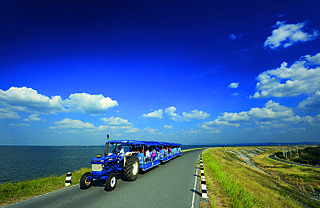
Lopburi is a province in the central region of Thailand. The province is divided into 11 administrative districts, and Mueang Lopburi district is the capital. With over 750,000 people, the province is Thailand's 36th largest area and 32nd most populous. There are eight neighboring provinces, Phetchabun, Chaiyaphum, Nakhon Ratchasima, Saraburi, Phra Nakhon Si Ayutthaya, Ang Thong, Sing Buri, and Nakhon Sawan.

Ram Khamhaeng or Pho Khun Ram Khamhaeng Maharat, also spelled Ramkhamhaeng, was the third king of the Phra Ruang Dynasty, ruling the Sukhothai Kingdom from 1279 to 1298, during its most prosperous era.

Loy Krathong is a Thai festival celebrated annually throughout Thailand and in nearby countries with significant South Western Tai cultures. The name could be translated as "to float ritual vessel or lamp," and comes from the tradition of making krathong or buoyant, decorated baskets, which are then floated on a river. Many Thais use the krathong to thank the Goddess of Water and River, Goddess Khongkha or to worship the Holy Buddha's hair pagoda in heaven in Buddhist beliefs. This festival traces its origin back to India.

Prajadhipok was the seventh king of Siam from the Chakri dynasty, titled Rama VII. His reign was a turbulent time for Siam due to political and social changes during the 1932 Siamese revolution. He is to date the only Siamese monarch of the Chakri dynasty to abdicate.

Thai people are a Southeast Asian ethnic group native to Thailand. In a narrower and ethnic sense, the Thais are also a Tai ethnic group dominant in Central and Southern Thailand. Part of the larger Tai ethno-linguistic group native to Southeast Asia as well as Southern China and Northeast India, Thais speak the Sukhothai languages, which is classified as part of the Kra–Dai family of languages. The majority of Thais are followers of Theravada Buddhism.

Pi is the generic term for any of a variety of quadruple reed oboes used in the traditional music of Thailand, piphat. It is very similar in construction and playing technique to Burmese Hne and Cambodian sralai.

The architecture of Thailand is a major part of the country's cultural legacy and reflects both the challenges of living in Thailand's sometimes extreme climate as well as, historically, the importance of architecture to the Thai people's sense of community and religious beliefs. Influenced by the architectural traditions of many of Thailand's cultures, it has also developed significant regional variation within its vernacular and religious buildings. Although Siam urged to identify themselves as a modernized state, Western culture and influence was undesirable and inevitable. In an attempt to become distinguished, Thailand's ruling elite gravitated toward selective Modernization to avoid the undesired Western influence.

Known as "Lavo" during most of its history, Lopburi Province is one of the most important cities in the history of Thailand. The city has a long history, dating back into the prehistory period since the Bronze Age of more than 3,500 years ago.

Fighter kites are kites used for the sport of kite fighting. Traditionally, most are small, unstable single-line flat kites where line tension alone is used for control, at least part of which is manja, typically glass-coated cotton strands, to cut down the line of others.
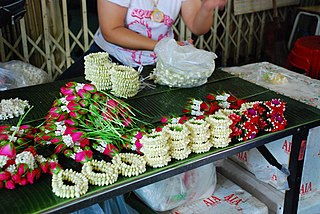
Phuang malai or malai are a Thai form of floral garland. They are often given as offerings or kept for good luck.

The ranat ek is a Thai musical instrument in the percussion family that consists of 22 wooden bars suspended by cords over a boat-shaped trough resonator and struck by two mallets. It is used as a leading instrument in the piphat ensemble.
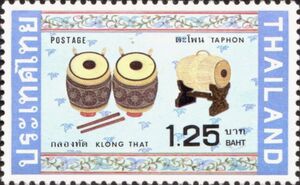
(Thai: กลองทัด, pronounced[klɔːŋtʰát]) are large barrel drums used in the classical music of Thailand. They are played with large wooden sticks. They are usually played in a pair and used in the piphat ensemble. Drums of this kind have also been called klong chatri (กลองชาตรี) and klong túk (กลองตุ๊ก).

The Lavo Kingdom was a political entity (mandala) on the left bank of the Chao Phraya River in the Upper Chao Phraya valley from the end of Dvaravati civilization, in the 7th century, until 1388. The original center of Lavo civilization was Lavo.

Phitsanulok Mansion or formerly known Banthomsinth House is the official residence of the Prime Minister of Thailand, located not far to the east from the government house in Dusit, Bangkok. The mansion was originally built at the behest of King Rama VI was and given to his aide-de-camp, Phraya Aniruth-deva.

Traditional games of Korea have been influenced by the culture, history and environment of Korea. Examples of popular traditional games include jegichagi, neolttwigi, ssireum, tuho, and yut.
Thai traditional games have been an integral part of Thai culture and traditions since ancient times. The Sukhothai period marked the earliest known traditional games in Thailand, as recorded in the stone inscription of King Ramkhamhaeng. Since then, Thai traditional games have evolved and been adapted over time, leading to the development of a wide variety of games across different eras. These games were originally designed to foster good relationships between adults and young people, as well as to provide entertainment, relaxation, and exercise. They are played with a set of rules and often feature music or songs to enhance the experience. Moreover, many traditional Thai games incorporate natural items such as sand, bamboo, rattan, mud balls, or banana tree stems, etc.
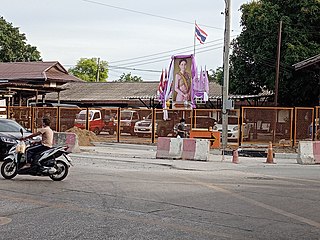
Ban Noen is a historic neighbourhood and road junction in Siri Rat and Ban Chang Lo subdistricts, Bangkok Noi district, Thonburi side, Bangkok. It is the three-way junction of Itsaraphap, Rot Fai and Sutthawat roads. The boundaries of the junction are considered to be where Rot Fai and Sutthawat roads originate, and where Itsaraphap road ends.
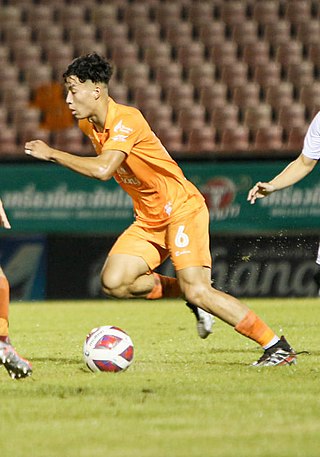
Leon Pitchaya James is a professional footballer born and raised in England who plays as a midfielder. Born in England, he represents Thailand at youth level.
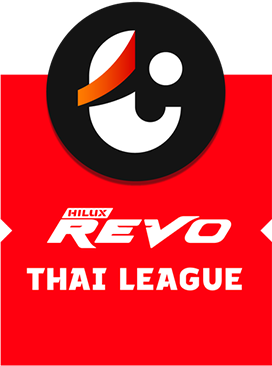
The 2022–23 Thai League 1 is the 26th season of the Thai League 1, the top Thai professional league for association football clubs, since its establishment in 1996, also known as Hilux Revo Thai League due to the sponsorship deal with Toyota Motor Thailand. A total of 16 teams will compete in the league. The season began on 12 August 2022 and is scheduled to conclude on 12 May 2023.



















